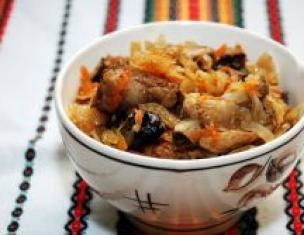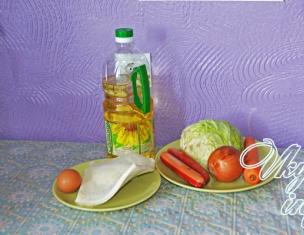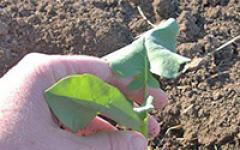Cauliflower is rich in vitamins, microelements and carbohydrates, but all of these components are contained only in seasonal produce. If you know how to store cauliflowerYou can use it throughout the year to prepare healthy and tasty dishes. It is worth considering that the greenhouse analogues of the product are practically useless. They can not be used for complementary foods, they will not benefit people suffering from diabetes, atherosclerosis, diseases of the liver and the gastrointestinal tract. Billets should be dealt with on time and carried out correctly. It is not enough to store the cabbages in the refrigerator, they need to be treated accordingly.
Preparing cauliflower for harvesting for the winter
For preparations for the winter is best to use vegetables grown on their own. In this case, it will be possible to control the harvesting process and carry out the preparatory stages in a quality manner:
- Wet heads of cabbage are not subject to long-term storage; therefore, harvesting is carried out in warm, dry weather. Over-grown cabbage loses a significant part of the useful components, so it is better to collect it a little ahead of time and independently conduct the ripening.
- Inflorescences need to be collected correctly - with the leaves covering them, you can not leave them in the sun, from the ultraviolet cabbage will quickly turn yellow and become useless. In some cases, the vegetable is dug along with the root.

Tip: If you plan to store cabbage in the winter, you should not feed the soil with nitrogen fertilizers. From such care, the vegetable spoils faster, even under all conditions.
- Fresh product should be slightly dried (it is possible in the open air, but under a thin cloth) and immediately proceed to bookmarking.
Properly conducted preparatory stage, ensures the preservation of the maximum amount of vitamins and trace elements in the composition of the vegetable. This is especially important if the preparation of mashed baby food or dietary meals is planned from the product.

How to store the product in the cellar or basement?
Despite the obvious tenderness of vegetable inflorescences, there are many ways to store cauliflower. If there is such an opportunity, then it is better to do it not in the apartment, but in a cold room with good ventilation and no signs of damp. The best option for this would be the cellar or basement.
- At the head of cabbage cut off the stalk and most of the leaves. Inflorescence fold in boxes, lined with foil. Between the vegetables leave gaps for ventilation. We cover the containers with a dark opaque film and place them in a room with a humidity of 85-90% and a temperature of 0 .. + 2ºС.
- Completely remove all the leaves and root, wrap the heads in polyethylene and fold them into boxes.
- Each fork is wrapped with cling film, creating vacuum conditions and stored in a suitable dark place.
- We release the cabbage with the root from the lower leaves, and cover the inflorescences with the upper ones and tie up the head with a rope. Roots are placed in clean sand, packaged in boxes. This bed should be covered with an opaque film and installed in a room with a temperature of 4-6ºС. This is the best way to ripen cabbage.
- You can hang the heads of the stalks, but the vegetables should not touch each other.
- Heads, completely peeled from the roots and leaves, one by one we lay out into the nets, which we hang under the ceiling.
- Peeled cabbage heads with a pair of leaves are wrapped in newspapers and folded in plastic bags with holes. Packages need to be changed from time to time, especially if condensation accumulates on them.
In the absence of the basement and cellar, you can use the balcony. Before storing cauliflower in an apartment, you need to make sure that the conditions described above can be created.
How can I store cauliflower in a fridge or freezer?
In the extreme case, cauliflower blossoms can be stored in the refrigerator, however, they will take a lot of places. We clean heads of stumps and yellow leaves, wrap them in cling film and put them in trays for vegetables. The variant with the newspaper and the package will also work, but the vegetables will have to be checked regularly, changing the wrapper.

In addition, it is necessary to constantly clean the heads of rotting leaves, cut off the darkened inflorescences, monitor the temperature in the refrigerator and regularly ventilate the room in which the unit is located.
Cauliflower can be frozen, but you need to do it right:
- Purified and washed head disassemble into individual inflorescences, boil them for no more than five minutes.
- Putting vegetables in a colander, waiting for the water to drain. Dried directly in the functional device or laid out on paper towels.
- We pack the product in plastic bags or containers, freeze it in an accelerated mode. From time to time it is recommended to shake up the container so that the elements do not stick together in one big piece. Packing of the vegetable for portions is allowed.

You can freeze and fresh cabbage, in this case, the cooking stage is excluded. But with this approach, the risk of spoiling the vegetable is much higher, and its taste after thawing will be slightly different from the usual. Re-freezing of cabbage is not allowed.

During storage, you need to track the quality of the products in the tab, throwing out damaged heads as needed or cutting out rotten inflorescences. Elements with signs of deterioration should be stored separately from the rest and used first.
Lose weight easily (result in 25 days)
Why stubborn dieting does not bring a visible result, but only leads to frustration and depression, and how can you still lose weight so that:
- Return the attention of her husband or find a new man.
- Feel the envious glances of girlfriends and colleagues again.
- Believe in yourself, feel slim and desirable.
- Do not hesitate to go to the cinema or in a cafe with friends.
- Do not hesitate to post photos from the rest or with children in social networks.
Burn fat specifically in problem areas
Recently, there have been many more supporters of proper nutrition and various diets. What is the difference between the diet of those who are more careful about their health or want to lose weight? First of all, in the increase in the volume of consumed fruits and vegetables, which are trying to replace sweet, farinaceous dishes, and sometimes meat dishes. Of all the variety of fresh natural products rich in healthy fiber and vitamins, cabbage, including cauliflower, occupies a special place. This article will be devoted to this very original in appearance vegetable. Below are useful tips, how to store cabbage, purchased in a supermarket or on the market. And what to do when growing natural raw materials in your backyard? The basic principles of how to store hand-made cauliflower are described, taking into account harvest time and other related factors.

Where, how much time and how to store cauliflower?
In specialized vegetable warehouses, the air temperature is usually kept at 0 ° C, and the humidity is no more than 95%. Such conditions are most favorable for storage. Cut heads with two or three leaves at the base can maintain their excellent presentation for 40-50 days. At home, fresh vegetables are usually kept in the refrigerator. In this case, the shelf life in this mode will not exceed 10 days. Therefore, in the case of bulk harvesting on hot days, it is worth considering, first of all, the possibility of processing raw materials. There are many recipes for home winter preparations in the form of canned salads or various "assorted" in combination with carrots, onions and other vegetables.
Tips for storing cauliflower grown in the summer on your own plot
There are some rules to follow when harvesting green crops:
- Loose and sprouted heads are not subject to storage. They should be used immediately for cooking various dishes.
- Do not leave cut inflorescences in the open sun. The presentation and taste of the vegetable will immediately deteriorate. The heads change their color to yellow and even purple.
- Cut cauliflower on warm summer days with high humidity tends to sprout. Therefore, for long-term storage, leave the fruits collected as late as possible and in dry weather.

The way how to store cauliflower in winter
Of course, until such a time it is impossible to preserve a fresh vegetable, even observing conditions that are ideal in terms of temperature and humidity. To eat dishes of dense inflorescences, you can choose one of two options. The first is to buy fresh food in supermarkets, because they are available there almost all year round. Second - stock up on cauliflower, preparing it in frozen form. Place it in small batches in plastic bags. Usually, the question immediately arises as to how to store cauliflower in frozen form - completely or disassembled into inflorescences? Carry out pre-treatment by cutting the cob into pieces, rinsing it well and flashing it for 2-3 minutes. in boiling water. After cooling, pack into packets and freeze. And then in the winter enjoy your favorite wholesome dishes!
fb.ru
How to Store Cauliflower for Winter at Home - Onwomen.ru
In Russia and Asia, cauliflower became popular not long ago, although about beneficial properties in Western Europe, known in the XVI century.
- Due to the presence of methionine and choline in cabbage, this vegetable is useful for people with diabetes, atherosclerosis, and for those with liver problems.
- In cauliflower there are vitamins: A, B1, B2, B3, PP, as well as trace elements: magnesium, calcium, phosphorus, iron ...
- Cauliflower is rich in carbohydrates.
- In cauliflower, there is less cellulose than in white cabbage, so it can be eaten with diseases of the gastrointestinal tract.
When to pick cauliflower
Cauliflower is harvested in several receptions as it ripens in sunny, dry weather, because wet cabbages are not subject to long storage and should be used as food as quickly as possible. For storage it is better to take cabbage later (autumn) harvest.
The heads are cut with 2-3 small covering leaves or twisted (dug out) along with the root. It depends on what kind of storage is chosen for cabbage.
Cabbage is dried in the fresh air for several hours, and then transferred to the room for further storage.
Cabbage can be stored in the cellar, in the basement, on the balcony and in the refrigerator.
How to store cabbage in the cellar or in the basement
Method 1. In cabbage cut stalk and part of the leaves.
The boxes are lined with foil and put cabbage there, leaving a distance between the forks for ventilation. From above the boxes are also covered with an opaque film.
Cauliflower is stored in a clean, well-ventilated area with an air temperature of 0-2 ° C and a humidity of 90-95%.
Method 2. Each head without leaves and roots is placed in thin plastic bags and stored in boxes.
Method 3. Each cauliflower head is carefully wrapped in food film, creating a vacuum, and in this form is stored in a dark cool place.
Method 4. The cabbage is dug together with the root, the lower leaves are torn off, and the rest are lifted up, weakly tying up the head with a string. Then the cabbage is planted in clean sand poured into boxes or directly on the floor. Be sure to cover this kind of garden with an opaque film. With this method of storage, the temperature should be about 4-6 ° heat.
This method is good for small heads that have not yet had time to ripen, as in this form they continue to grow.
Method 5. If cabbage stumps are not cut off, cabbage is hung behind them “upside down”, but so that the heads do not touch each other.
Method 6. Heads without leaves and roots are folded one at a time into meshes and hung from the ceiling.
Method 7. Clean cauliflower heads with one or two leaves are wrapped in newspapers, then put in plastic bags with several holes and stored in this form. A little later, the leaves break off, and the bags periodically change due to collecting condensate. Of course, you need to monitor the status of the paper.
How to store cauliflower in an apartment
If there is no basement or cellar, then cabbage can be stored on a warmed balcony, where the temperature does not fall below 0 ° even on frosty days. Cabbage is stored in the same way as the basement.
How to store cauliflower in the refrigerator
Cabbage without cobs and yellow leaves is well packaged in food film and stored in the vegetable compartment.
You can wrap the cabbage in paper, and then put in a plastic bag. But you need to change the packages as they appear condensate.
But whatever method is chosen for storage, it is necessary to periodically check the safety of the crop:
- Remove from the cabbage rotted and yellowed leaves.
- Shift cabbage, removing spoiled heads.
- Change cellophane and paper due to condensation.
- Air the room.
- Ensure that the temperature is kept within acceptable limits.
How to store cabbage in the freezer
Cauliflower can be easily frozen.
- To do this, washed cabbage is taken apart into florets and boiled for 3-4 minutes.
- Then inflorescences recline on a colander and wait until they dry out.
- Then put them in plastic bags or plastic containers and freeze.
You can freeze and fresh cabbage. To do this, clean cabbage disassembled into inflorescences is dried from moisture, put in plastic containers and frozen.
Frozen cauliflower is used as needed.
After thawing the cabbage is not subject to re-freezing.
OnWomen.ru
Save the cauliflower for the whole winter
Cauliflower -
When to pick cauliflower? Or "Overdrell? - Unfit!"
“Cold” harvest or the longest fresh storage of cauliflower
Save life "flower" or how else can you store cauliflower?
- Probably the longest way to store cauliflower is freezing. Yes it is not fresh cabbage, but a reliable way to eat sweets for at least six months. You can freeze as raw cabbage, and a little cooked. But in one and in another method of freezing, you should wash the cabbage heads and disassemble them into smaller inflorescences. Water should be thoroughly drained and let the buds dry out. The method of blanching (boiling) cabbage is the same as for kohlrabi. Store cauliflower prepared in this way can be from 6 to 12 months in the freezer in a separate package.
6cotok.org
How to keep cauliflower fresh? Is it possible to do this for a long time? Yes, there are such methods. Today I will talk about how to keep cauliflower fresh until spring, and also in frozen form.
Cauliflower - This is the second most popular species grown in Russia. Of course, the first place is white cabbage. What is the origin of its name? From the fact that, depending on the variety, it has a different color? Maybe. But it is more likely that from the word "bloom." After all, it is really beautiful and looks like a flower. And what delicious dishes can cook from it.
That's just storing cauliflower sometimes causes difficulties. More precisely, the difficulty is the lack of knowledge of some possibilities and methods. An important point is the time of its cleaning.
when to pick cauliflower? or "overripe? - unfit!"
While harvesting cauliflower, you need to remember a few rules.
- First, harvest heads begin in the period of growth. When they reach a diameter of 8-12 cm, it will be about 300-1200g by weight. If the vegetable grows out, it will lose a significant part of its healthy and palatable qualities. Yellowed and crumbly plant - clearly overripe.
- Secondly, when you remove the cauliflower, cut it with a knife carefully, leaving 2-4 leaves. If she has formed shoots, you can try to grow new inflorescences. To do this, leave one or two strong escapes, and remove the rest. Caring for vegetables should be the same as in normal planting.
- Third, cut the head in any case can not be left in direct sunlight. Otherwise, they immediately begin to turn yellow and as a result will become simply unfit for human consumption. And you don’t want to lose a crop, do you?
Something about Cauliflower Harvesting
Early varieties ripen within 60-100 calendar days, and you can harvest the first crop in June. Usually this procedure occurs selectively in 2-3 approaches. When the heads have already formed, but have not grown to the desired size, it is recommended to priten them with broken leaves of the same cabbage. The ripening time of medium varieties is 100-135 calendar days, and the later ones will grow for at least 5 months. In general, you can harvest a fresh crop until late autumn.
“Cold” harvest or the longest fresh storage of cauliflower
How to store cauliflower, if you store almost nothing? I mean the situation when the cold came before the cauliflower ripened. She is still so small that enough for one tooth. What to do in this case? Is it all gone? Not. There is a great way, which is called rearing. Practically, it is transplanting cabbage into a cellar or greenhouse. And here it is.
Heads with a diameter of 3-5 cm are dug up together with roots and lumps of earth (for two days it is advisable to water them abundantly) and transplanted into the prepared room very closely to each other (30-40-40 plants per 1 m2). Fill with earth centimeters 15, to the leaves. By the way, just they will serve as a source of essential nutrients. The main rule of such storage of cauliflower is no light. Otherwise, everything will go down the drain. Therefore, the heads should be covered, for example, with a dark plastic wrap or a wooden shield.
The conditions of fruitful growing-growing: air temperature is + 4-10 ° C, relative humidity of air is not less than 95%. As a result, the harvest can be obtained in 1-4 months (the variety also influences the time). By the way, this method is suitable not only for the unripe ripened cabbage, but also for the ordinary desire to provide themselves with this vegetable for almost the whole year. This is both the cultivation and storage of cauliflower.
save life "flower" or how else can you store cauliflower?
There are more ways to store this cabbage:
- In a cellar at a temperature of about 0 ° C and a relative humidity of about 95%, you can place boxes (wooden or polymeric) or boxes with cauliflower heads cleared of leaves and roots and covered with plastic wrap. So they can be stored up to 7 weeks. But still check your cauliflower from time to time for various diseases. It is better to check and make sure that it is safe, than not to check it and then throw most of it onto the compost heap.
- At the same temperature and humidity of the air, but in a state suspended from the stalk, you will be able to store cauliflower for about 3 weeks.
- Store cauliflower in the fridge. To do this, place the cabbage heads (without roots and without leaves) in a plastic bag. Give each cabbage a personal storage house, that is, one head - one packet. You can wrap the heads of cauliflower, pre-peeled from the roots and leaves, and in the cling film. But, alas, this option will extend her life only for a week.
- Probably the longest way to store cauliflower is freezing. Yes, this is not a fresh cabbage, but it is a reliable way to eat snacks for at least six months. You can freeze both raw cabbage, and a little boiled. But in one and in another method of freezing, you should wash the cabbage heads and disassemble them into smaller inflorescences. Water should be thoroughly drained and let the buds dry out. The method of blanching (boiling) cabbage is the same as for kohlrabi. Store cauliflower prepared in this way can be from 6 to 12 months in the freezer in a separate package.
How to store cauliflower now you know. Yes, it is not white cabbage, it is more difficult to store it, but, nevertheless, it also has different ways prolong her life.
When to remove broccoli cabbage from the garden?
When to collect broccoli for storage?
Slana22
Broccoli is a very useful vegetable. It can be given even to the smallest children as a complementary food, because broccoli is well absorbed, contains many vitamins and does not cause allergies. Broccoli requires care, loves moisture, and still prefers sunny places to grow. But you need to clean the broccoli cabbage before the flowers bloom. This period can be easily missed, so watch your cabbage carefully, do not miss the moment when it can overeat. First, the cabbage ready for harvesting should have a head about 10-15 cm in size, which is slightly less than the female palm. Its color should be dark green, and all buds are closed. If they start to turn yellow, it means that the cabbage has blossomed and it must be urgently collected. Of course, you can collect and yellowed cabbage, but its taste and benefits will be completely different. To the cabbage did not fade to clean it better early in the morning, and cut only the central head and a sharp knife. Usually, from the moment of emergence of shoots, it should take about two months before you need to clean it. As a rule, harvest occurs in the first month of autumn. Do not forget that you need to have time to clean the broccoli cabbage before the onset of frost.

Aleso
himerka

Andrey0817
Do not wait until broccoli grows on your head-size bed, otherwise it may color.
Small green buds that covered this cabbage should not be dissolved. It is better to cut it earlier than later.
Sometimes the inflorescences do not close tightly and there is a short distance between them, but this does not mean that it is not ready, just in the soil there were few nutrients for it.

angren
Broccoli cabbage should be cut off when even the cabbage leaves are dense and bright green. Cut off the central heading, it is usually larger, in the axils there are still small inflorescences. If the cabbages began to disintegrate, not so dense, yellow flowers began to bloom, then such cabbage is no longer good for food. Broccoli is poorly stored, it must immediately be recycled, you can boil it and freeze it.
Surprisingly, this diet, tasty and useful product, like cauliflower, is very simple in agricultural technology. All that is required for obtaining a bountiful harvest is moderately warm weather, sufficient watering and regular fertilizing with fertilizers containing additional trace elements (manganese, molybdenum, magnesium and boron). Even a novice gardener can handle it. There is one trick when growing cauliflower: for greater density of their heads during growth it is recommended to shade from sunlight.
Harvest time
If since the beginning of the season you have been properly caring for vitamin plantings, then in the middle of summer you will receive a well-deserved reward - a lot of dense, snow-white (or purple, orange, emerald) inflorescences. And now the main task is to collect the grown in time and preserve the harvest as long as possible. Terms of harvesting primarily depend on the characteristics of the selected variety.
- Early cabbage will form full-fledged inflorescences in 2-3 months. Thus, the first fruits can be tasted in late June - early July.
- Mid-season varieties require a period of active growing season lasting from 100 to 130 days. They will decorate the garden with cabbage "bouquets" in the second half of summer.
- Late varieties will be pleased with a bountiful harvest only at the end of August or September, since they require at least 5 months to grow and develop. But such cabbage will be stored much longer than its earlier relatives.
Experienced gardeners know that the stated time of ripening does not always coincide with the actual. After all, the process of vegetation is influenced by many factors.
- The optimum temperature for timely ripening should be in the range from +15 to + 20 ° C. At lower values, plant growth slows down significantly, and too warm (over + 25 °) air leads to the formation of defective (small and friable) inflorescences.
- The lack of moisture in the soil can lead to sad results. With a shortage of water, too small and insufficiently dense heads are formed.
- Cauliflower is very sensitive to the level of illumination. With an excess of sunlight, the inflorescences are not just too quickly formed, but also prone to sprouting. To prevent this from happening, with a prolonged light day, it is recommended to prune barely formed heads.
- The intensity of the development and fruiting of plants depends greatly on the fertility of the soil, including the content of the necessary micro and macro elements in it. On poor soils, cabbage develops more slowly and later forms inflorescences that rot very quickly.
How to collect cauliflower?
A bountiful harvest is important to collect not only on time, but also correctly. Only then can appetizing strong heads last long enough.
- Cabbage should be cut at the moment when the inflorescence will increase in size to 10–12 cm in diameter. Larger specimens are often already unsuitable for food, they turn yellow and become friable.
- It should be noted that ripe cabbage should not be on the plant, but requires immediate harvesting. Therefore, the crop is harvested gradually, revising the planting every 2-3 days. If you do not have such an opportunity, be sure to cover the ripping heads from the sun. This measure will slow down the process somewhat.
- For cutting heads use a sharply sharpened knife. The inflorescences are removed along with several bottom leaves. For prolonged storage, it is possible to remove the entire plant along with the root system.
- If the heads have not yet been completely formed, and the weather conditions do not allow the plants to remain in open ground, they can be transplanted into a greenhouse or cellar for final re-growth without access to sunlight. In this case, the inflorescences should already be about 5 cm in diameter and grow at least 20 leaves.
- Harvest should be immediately removed to storage or another dark and cool place. The inflorescences left in the sun will wither very quickly and lose their nutritional value.
Ways to preserve the harvest
Cauliflower - the culture is very delicate. In a freshly cut state, it can be stored for no longer than 7 weeks, and then only if certain requirements are met.
- The most common and effective way to keep matured heads is to stack them in wooden or plastic containers, and then send them to a room with high humidity (up to 95%) and temperature conditions of 0–2 ° C. So the cabbage will remain fresh for almost two months.
- If, under the same conditions, cabbage is simply hung upside down, it will remain lossless for 3-4 weeks.
- The laborious, but the longest way to store fresh cabbage is to transplant it into boxes of soil, located in a dark and cool (+ 4–10 ° C) cellar. To do this, pre-plentifully watered plants are dug together with the roots and very densely planted in the prepared container, falling asleep with soil to the leaves. The main condition for such storage is absolute darkness. Therefore, if there is a source of light in the room, the cabbage should be tightly closed with any opaque material. In this state, the crop will not lose freshness for several months (from 1 to 4, depending on the variety), and small specimens will even grow.
- You can save part of the crop in the freshness zone of the refrigerator, if you wrap the inflorescences tightly in the food film, after cutting the leaves and stumps. If there is no film, use a regular plastic bag, closing it tightly.
- The longest storage of the crop (up to 12 months) is possible in frozen form. To do this, the heads should be pre-disassembled into separate fragments, thoroughly washed and dried, and then frozen. Some housewives recommend that with this method of storage, pre-lightly boil the cabbage.
Cauliflower, like other crops, has its own ripening period, if broken, it either does not reach its full size, which means that you will lose part of the crop, or this will affect its taste and storage. Much depends on the variety. If the packaging of seeds you bought says that the heads grow up to 2 - 3 kg, this does not mean that it will be so. You will spend a lot of unjustified forces and negative emotions to accomplish this feat. Therefore, tune in to the average yield, in the region of 0.5 - 1.5 kg, and do not wait until your cabbage, because of someone's advertising, starts to deteriorate. So, we conclude: cauliflower should be collected as its heads ripen.
Cabbage is better to cut just below the formation of the head, capturing a pair of leaves. At non-observance of terms of cleaning, the cauliflower starts to sprout and deteriorate, especially it occurs at a warm and damp weather at the end of summer and the beginning of autumn. Perhaps your heads were not protected from direct sunlight in the fall, then they begin to turn yellow or become purple in color. Such signs may also appear after cleaning.
It is enough for heads to lie for 5 hours in the area under direct sunlight to spoil their presentation and taste. Therefore, do not leave heads in the open. Crumbly and sprouted heads should be immediately rejected, since they will not be stored. With partial germination, such heads should immediately be used for food. Cauliflower, like other crops, tends to form generative organs, i.e. the future generation, or even easier - the seeds. In this case, small and hard heads are formed, in an unattractive shape, from which leaves begin to sprout (and heads on such plants appear much earlier than usual).
The main reason for this may be the suspension of leaf growth, due to overgrown seedlings, soil compaction, drought or malnutrition. A lot can be said about nutrition, but the most important for cauliflower are two elements - molybdenum and boron. With a lack of boron voids are formed, the head begins to rot. If you have noticed such signs, then it will be enough to add boric acid to the soil during planting, as well as fertilizing.
To extend the time of receipt of fresh heads on the table, grow cauliflower in indoor conditions, as well as greenhouses and greenhouses. For this you need to grow high-grade plants with developed leaves and stems. In this case, the seeds are sown in early July, in the area freed from the early crops. For these purposes, fit any plants that did not have time to form heads before the onset of stable frosts.
For rearing, choose plants with a large number of leaves, healthy in appearance and a head, with a diameter of 3-5 cm. Dug out plants with a clod of earth are transferred to the place of rearing. The plant is planted in a moist soil, on the level of growth that was with constant growth. Such plants can be planted quite thickly, 300 - 400 pieces per 10 square meters. Dried and rotten leaves must be removed, so that the air is below the plants. Humidity should be at 70 - 90%. With such rearing nutrients moves from the leaves to the heads and in 20 days such a plant at 15 ° C is capable of giving a head weighing 200 - 300 g.
Cut-off heads can lie down under certain conditions for 50 to 60 days. After cutting the heads with two or three sheets, they are cut at the level of the head. The optimum temperature for cabbage storage is 0 - 1 ° C, with a relative humidity of 95%. The concentration of CO2 should not exceed 4%, because the taste of the product is significantly deteriorated. Cabbage should not be stored with an increased content of ethylene, it causes rapid aging of the head and reduced shelf life. It is possible to store cauliflower in refrigerators, but there it will lie only up to 10 days.
Cauliflower can be canned and frozen. To do this, the heads must be dense, white or cream colored, without sprouted inner leaves, on short peduncles.









